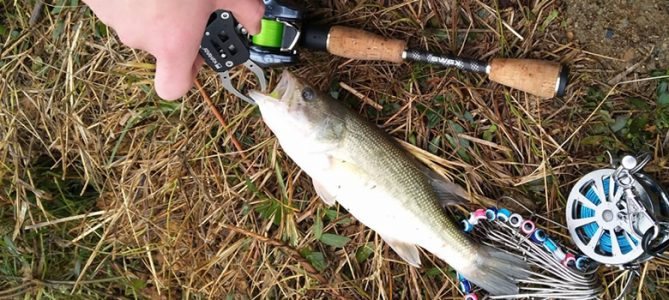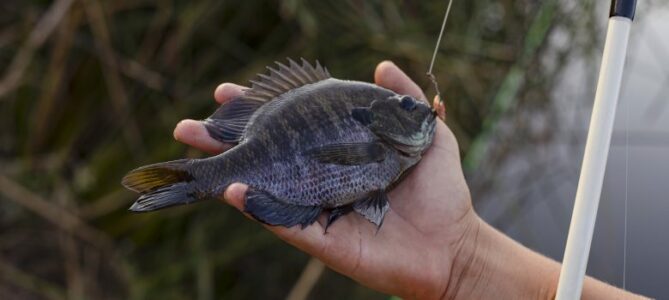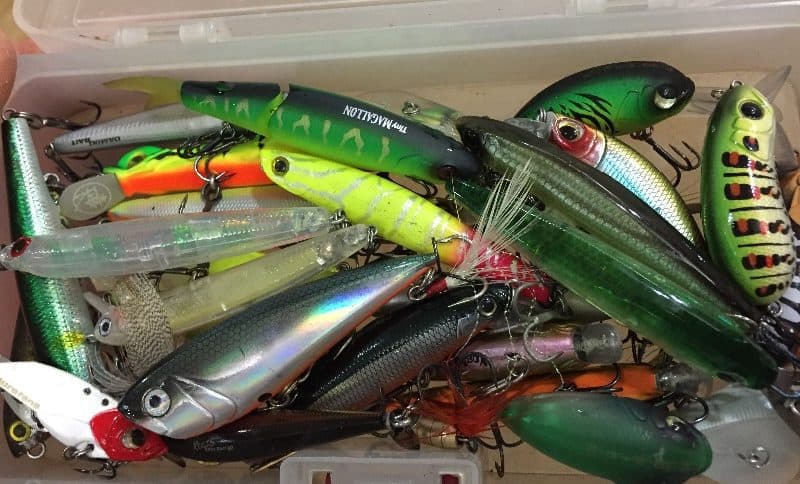If you buy via a link on this page, we may receive a commission, at no extra cost to you.Learn more
I’ve been fishing for bass since I was old enough to hold a rod. Throughout the years, I have managed to catch all the different bass types, and I have learned how to differentiate them. This is an important skill. Believe me. You don’t want to make a fool of yourself by pointing out the wrong specimen.
That’s why today we will take some time to talk about the differences between Spotted Bass and Largemouth Bass. We will review aspects such as:
- Color
- Size
- Fins
- Jaws
We will also discuss the habitat, diet, and other bits and pieces. So make sure to stick around. In the end, you will have enough information not to mistake them ever again.
How Many Types of Bass Are There?
There are around 10 unique bass specimens. However, they are grouped into two categories: Temperate and black bass.
Temperate bass, scientifically known as Moronidae, includes yellow, striped, and white bass. In contrast, the Black bass family includes largemouth, smallmouth, and spotted bass.
In this case, both spotted, and largemouth bass is part of the same group. No differences thus far.
Largemouth Bass Vs. Spotted Bass: Coloration

Only time and a trained eye can tell the differences in coloration between largemouth and spotted bass. Both have silver bellies with a greenish upper body. However, you will know if you are holding a spotted bass if it has several dark spots running vertically. This is the key difference between the two.
There is another subtle tell: The Ventrolateral stripes. Largemouth bass doesn’t have them, while spotted specimens do.
One last difference that took me a while to identify is the color of the tail. The one in the largemouth bass is darker. I noticed this difference a while back, and the truth is that it is the quickest way I have to determine which fish I have on the line.
Fins: Similar Not Yet The Same
It takes time to notice any differences in this department. The fins are identical at first glance. However, there are some subtle differences once we zoom in.
For example, while both have two dorsal fins, the ones in the spotted bass are connected via a membrane. No such thing exists on largemouth bass. Here, both fins are completely separated.
Additionally, the spotted bass dorsal fins are rounded. Plus, they have some tiny scales near the base. In contrast, the fins of largemouth bass have no scales.
I know. It takes time and attention to detail to spot these differences. But at least these tiny details will help you to be sure about which bass you are holding.
Largemouth Vs. Spotted Bass: Jaws
Just like the spotted bass is named after its dark spots, the largemouth nickname comes from its jaws.
If you lay a largemouth bass flat, you will notice that the jaw extends past the eye. By doing the same with spotted bass, you will notice its jaw ends at the eye. In other words, the mouth is larger in largemouth bass. Thus the name.
In Doubt? Look Inside the Mouth
Yes, it is a little extreme. But if you peek inside the mouth of each fish, you will notice a singular difference. Largemouth bass has a smooth tongue without a tooth patch. Spotted bass, however, has a single tooth patch on the tongue!
Hopefully, it won’t come to this to identify which bass you have.
Size and Weight
Although you will have the fish identified by now, you must know they are not the same size and weight. Largemouth specimens are typically longer, around 16 inches. Sometimes they can grow as large as 30 inches! While the heaviest catch reported was 22 pounds.
Spotted bass are notably smaller, averaging 15 inches. They can grow as large as 22 inches. But it is not common to find such specimens.
Spotted bass are also lighter, with an average weight of 4.5 pounds.
Many anglers wonder why the difference. If I have to guess, I think it is due to their respective lifespan. Spotted bass live around seven years, while their largemouth counterparts can last 16 years!
Diet
Both fish eat the same food. This includes:
- Crayfish
- Small fish
- Frogs
- Insects
Nevertheless, I’ve noticed that largemouth bass tend to feed more aggressively than their brother. You might find it easier to catch them as a result.
Habitats
Although you might find them in the same body of water, both fish favor different things. For once, the largemouth bass loves murky waters with lots of cover. They are also quite sensitive to temperature changes. That’s why you have to fish deeper during the summer months.
Spotted bass, on the other hand, prefer clear waters. Suppose they are slow-moving waters, the better. I’ve also noticed that they don’t like the weeds as much as largemouth bass do.
Nevertheless, you can find both living in the same body of water. That’s the main reason behind the confusion.
Can You Eat Spotted Bass?
Both largemouth and spotted bass are safe to eat. Some people are concerned about the mercury levels. As you know, fish can’t purge mercury out of their systems. Therefore, it accumulates inside them, passing to the next being that eats them. Typically, the older the fish, the higher the level of contamination will be.
I suggest checking with the local Department of Wildlife. This way, you can make sure that the fish you catch are safe to eat.
I don’t have a personal favorite between both. For me, they both taste the same.
Why is it Called Spotted Bass?
As we discussed before, spotted bass got their name from the dark spots on their body.
The same goes for largemouth bass. Its name comes from the fact that its jaws extend past the eye. Their mouths are bigger as a result.
Are Spotted and Largemouth Bass Endangered?
Thankfully they are not. They are categorized as Least Concern. But this doesn’t mean that you can catch as many as you want. Make sure always to check the local fishing regulations. Plus, we encourage you to practice catch-and-release fishing.
Keep in mind that for catch and release to be effective, you must do minimal damage to the fish.
Largemouth Bass and Spotted Bass: Learn How to Differentiate Them
It is not a surprise when anglers always confuse largemouth with spotted bass. They inhabit the same bodies of water and belong to the same family. Plus, they look fairly similar.
However, both have some distinctive features. You only need to know where to look. The first is the dark spots only present on spotted bass. On the other hand, the jaws are longer on the largemouth bass.
If you are still unsure, you can take a look inside its mouth. If it has a single-tooth patch, it is a spotted bass. If it has none, it is a largemouth bass. But let’s be real. It shouldn’t come to this!
There are other subtle differences. But the dark spots and the jaws are the two differences that set both apart.




